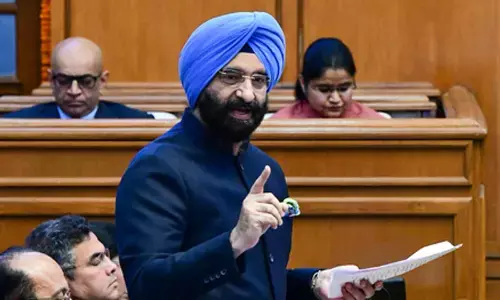Is Jaish-ul-Hind IM's revived, new face?

Is Jaish-ul-Hind IM’s revived, new face?
The emergence of a new terror outfit, Jaish-ul-Hind (JuH), and its links with jailed Indian Mujahideen (IM) operative Tehseen Akhtar have left the country's intelligence agencies, the NIA and police forces of Mumbai and Delhi working on the same line of investigation.
The emergence of a new terror outfit, Jaish-ul-Hind (JuH), and its links with jailed Indian Mujahideen (IM) operative Tehseen Akhtar have left the country's intelligence agencies, the NIA and police forces of Mumbai and Delhi working on the same line of investigation.
Two major questions are yet to be answered-- whether the IM has come up with a new identity as the JuH or is IM's underground network is being revived to work with JuH.
The National Investigation Agency (NIA) has begun a pan-India operation to dig out answers to these questions. Meanwhile, Delhi Police's Special Cell and Mumbai's Anti-Terrorist Squad (ATS) have engaged more than two dozen groups of officials to find out links between the two recent terror incidents reported from Mumbai and Delhi within a span of two months. These incidences gave birth to little-known JuH and raised doubts about whether IM was trying to revive itself.
Of the two terror cases, the recent one was reported from Mumbai in which an SUV laden with 20 gelatin sticks was recovered outside industrialist Mukesh Ambani's Antilia residence on February 25 and the other in which a minor blast took place in a car near the Israel embassy in Delhi on January 29. In a message, JuH claimed responsibility for the move but in another letter, the group denied its role.
A group of investigators said JuH was created inside Tihar Jail No. 8 — which houses prisoners, including those from IM and Al-Qaeda -- who have been sentenced for cases of terror. However, another group of investigators said JuH might have been created outside but IM operatives who went underground are now being used to support the group.
In a new development to the Antilia bomb scare and the blast outside Israeli Embassy cases, the Special Cell cops of the Delhi Police are set to question IM terrorist Tehseen Akhtar alias Monu in Tihar Jail after two mobile phones were recovered from his barrack.
The investigation so far has revealed that a mobile handset has been seized from Akhtar's barrack in jail No. 8, which was allegedly used to send Telegram messages claiming responsibility for parking an SUV with 20 gelatin sticks outside Ambani's south Mumbai residence.
The development has come after Tihar Jail authorities had found two mobile phones, one of the Oppo company and another of Vivo. Both the phones have been handed over to the Delhi Police Special Cell.
As the investigating agencies have little option to track the main link, the Special Cell of Delhi Police has been assigned to get details from IM operative and IED expert Aktar. 'Tech-savvy' Akhtar is known for his alleged involvement in a series of blasts in the country since 2010.
Preliminary investigations suggest that the Telegram Channel was being operated by not more than a dozen people. It is a matter of investigation whether these terrorists used this phone to claim responsibility for terror acts or threats including for placing an explosives-laden SUV near Ambani's residence and blast outside Israeli embassy in Delhi.
Akhtar was convicted in 2016 for his alleged role in the 2013 Hyderabad twin bombings that killed at least 13 people and injured over 100 others. In March 2014, Akhtar, then 24-year-old, was arrested from Naxalbari in Darjeeling district of West Bengal by the Special Cell of Delhi Police.
The announcement of his arrest had come just three days after the arrest of top IM operative and Pakistani national Zia-ur-Rehman alias Waqas from Rajasthan, and security agencies believed this to be a major setback for the outfit.
Akhtar, according to the police, became the operational chief of Indian Mujahideen after the arrest of its co-founder Mohammad Zarar Siddibappa alias Yasin Bhatkal from India-Nepal border in August 2013.
Bhatkal is said to have informed the investigators at the time of his arrest on August 29, 2013 that Akhtar is the India head of IM and deals directly with Karachi-based operative, Riyaz Bhatkal. He was said to have been managing modules across India. The NIA had subsequently announced a reward of Rs 10 lakh on Akhtar.















